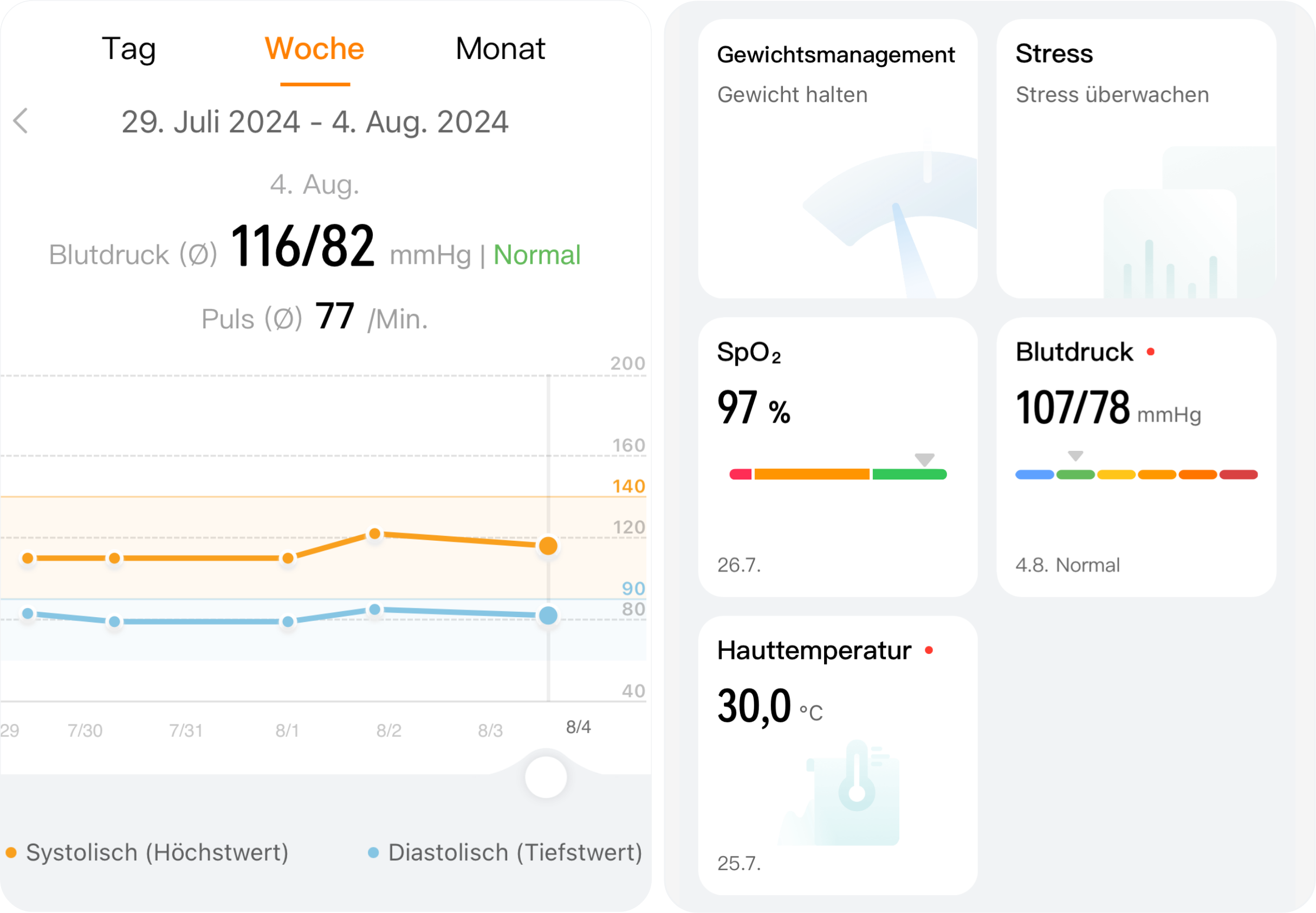Blood Pressure
On-The-Go – Monitor
From Your
Wrist Anytime, Anywhere

Reading duration: Approximately 6 minutes
Measuring blood pressure at an early stage can help recognise risks and aid the decision to take appropriate measures. All adults aged 18 and over are recommended to keep an eye on their blood pressure and be aware of the importance of regular monitoring. Monitoring parameters such as blood pressure, oxygen saturation (SpO2), heart rate and electrocardiogram (ECG) in everyday life with a smartwatch such as the HUAWEI WATCH D2 offers a valuable opportunity to keep an eye on cardiovascular health.

Prof. Dr. David Duncker
Prof. Dr. David Duncker is a cardiologist and electrophysiologist and heads the Hannover Heart Rhythm Centre at the Department of Cardiology and Angiology at Hannover Medical School. He was a member of the EHRA Young EP Committee 2018-2020, was an EHRA Board Member and Chair of the EHRA e-Communications Committee 2020-2022. He is currently a member of the EHRA Board and Chair of the EHRA Digital Medicine and e-Communications Committee 2022-2024.
In this article
Why is Measuring Blood Pressure Important?
How Do I Measure my Blood Pressure?
How Accurate is the HUAWEI WATCH D Series?
Measuring Blood Pressure on the Wrist: How it Works with the HUAWEI WATCH D
Analysing the measurement data
Smartwatches in Practice: Supporting Both Users and Healthcare Professionals
Conclusion

Why is Measuring
Blood Pressure
Important?
Blood pressure is an important indicator of the health of the cardiovascular system.Optimal
blood pressure is below 120/80 mmHg. Elevated values indicate high blood pressure, which should
be treated.
The problem is that high blood pressure often goes unnoticed, as those affected usually do not
experience any symptoms. Regular blood pressure checks are therefore recommended, regardless of
whether symptoms are present or not.
A more intensive check for high blood pressure is particularly important for patients with risk
factors. These risk factors include, among others:
•Age
•Active or former nicotine consumption
•Elevated cholesterol levels
•Diabetes mellitus
•Overweight
•Family history of premature cardiovascular disease (men at < 55 years old, women at < 65 years
old)
•Family history of high blood pressure at a young age
•Kidney diseases
Good to Know: Difference between Systolic and Diastolic Blood Pressure
When you measure your blood pressure, you get two values: systolic and
diastolic blood pressure. But what exactly do these values mean?
•Systolic blood pressure: This is the higher of the two values and indicates the pressure
in the arteries when the heart beats and pumps blood into the body. A normal systolic value in
adults is typically below 120 mmHg.
•Diastolic blood pressure: This is the lower value and measures the pressure in the
arteries when the heart is resting between beats. A normal diastolic value in adults is below 80
mmHg.
Both values are crucial for assessing your blood pressure. An elevated systolic or diastolic
reading can be a sign of high blood pressure, which should be treated to avoid long-term health
risks.
How Do I Measure my Blood Pressure?
Blood pressure measurements are often taken during a (home) doctor's visit or by
means of a long-term blood pressure measurement over 24 hours (24-hour blood pressure measurement).
These methods offer valuable insights, but they are often only snapshots and require considerable
organisational effort.
Many patients therefore do not use these options regularly, which makes continuous monitoring more
difficult.
Regular self-measurements are much more effective. Many smartwatches now also offer the option of measuring your blood pressure conveniently and independently. I took a close look at both the HUAWEI WATCH D and HUAWEI WATCH D2 and tested them. This smartwatch series makes it easy to measure your blood pressure at home - at any time. The HUAWEI WATCH D2 measures blood pressure via a pressure cuff in the wristband and is currently one of the only smartwatches that can perform ambulatory blood pressure measurement (ABPM). It’s is quite an innovation, as this function enables continuous measurements at 15, 20, 30, 45 or 60-minute intervals over 24 hours, including day and night. This means that you can now even measure your blood pressure while sleeping or exercising.

HUAWEI WATCH D2
Ambulatory Blood Pressure Monitoring Precisely manage your health every moment
All-round Health Management
Light and Slim Design
Smart Living Experience Bluetooth calling, music playback and more
Medically Certified
Compatible with iOS and Android

How Accurate is the
HUAWEI WATCH D Series?
I compared the readings from both the HUAWEI WATCH D and the HUAWEI WATCH D2 to those from traditional cuff-based devices, and the results were comparable. The HUAWEI WATCH D2 is also characterised by its ability to provide a comprehensive 24-hour blood pressure curve that can detect variations, and therefore it can be extremely helpful to export the collected data and bring it with you to a doctor's appointment for analysis.
While both the HUAWEI WATCH D and D2 are CE-certified for personal use, it’s important to note that it is not a replacement for clinical-grade devices. However, it is far more convenient for everyday use.
This watch series uses a cuff similar to traditional monitors, setting it apart from many other
smartwatches that rely on PPG (Photoplethysmography) technology, which is less accurate, as
a study has shown [3]. The HUAWEI WATCH D and HUAWEI WATCH D2 are one of the few, if not the only, cuff-based non-PPG blood pressure watches on the market, making it really interesting for people suffering from high blood pressure.
The HUAWEI WATCH D and HUAWEI WATCH D2 are particularly user-friendly and offer a practical solution for those who want to monitor their blood pressure regularly without resorting to the traditional cuff. However, care should be taken to ensure that the blood pressure measurement is carried out carefully.

Self-measurements of blood pressure offer patients an unprecedented opportunity to continuously monitor their state of health and react to changes at an early stage. This is a real innovation and can significantly improve the care of our patients.
Measuring Blood Pressure on the Wrist: How it Works with the HUAWEI WATCH D
In order to take a blood pressure measurement with a HUAWEI WATCH D and HUAWEI WATCH D2, you should avoid disruptive factors such as movement while cycling or driving. Here are some important tips that you should follow in order to obtain correct and meaningful measurement results.
Tips for Precise Blood Pressure Measurement
1. Time of measurement: Carry out the measurement in the morning and evening in a quiet room after a rest period of about five minutes.
2. Sitting posture: Sit down and make sure that your back and arm are supported.
3. Cuff size: Ensuring the cuff size fits your wrist is crucial for accurate readings. For standard blood pressure monitors, the cuff should match commercially available sizes. Smartwatches like the HUAWEI WATCH D and HUAWEI WATCH D2 offer different strap sizes, allowing you to choose the right size based on your wrist circumference.
4. Correct positioning: The smartwatch should fit snugly but comfortably on your wrist. The
sensors should be in direct contact with the skin.
5. Keep calm: You should not speak or move during the measurement.
6. Cardiac arrhythmia: If cardiac arrhythmia is present, this can influence the measurement. If
necessary, additional measurements should be taken.
7. Measurement on both sides: In some cases, it may be useful to measure both arms. Differences
in the measurements can be an indication of circulatory problems.
1. Correct positioning: Make sure that the smartwatch is correctly positioned on your wrist
and that your arm is at heart level.
2. Open the app: Start the blood pressure measurement via the corresponding app on your
smartwatch.
3. Stay relaxed: Breathe calmly and remain relaxed during the measurement. (The measurement
should take 30-60 seconds.
4. Display results: Check your measured values in the HUAWEI Health App and save them for
later analyses.
Analysing the
measurement data

It is important to regularly check and evaluate the recorded blood pressure values. The HUAWEI WATCH D and HUAWEI WATCH D2 automatically alerts you of any irregularities, helping you stay aware of potential health issues. If elevated values are detected even though there are no symptoms, a GP should be consulted to discuss further measures. For patients who are already being treated for high blood pressure, deviations in the measured values may indicate to a healthcare professional that treatment needs to be adjusted.


Smartwatches in
Practice: Supporting Both Users and Healthcare
Professionals

As a healthcare professional, I’ve seen how smartwatches like the HUAWEI WATCH D and HUAWEI WATCH D2
can be a very valuable tool for people suffering from hypertension. One of my users a 62-year-old woman
who loves horseback riding, found it inconvenient to monitor her blood pressure with traditional methods,
especially during her active lifestyle. Smartwatches like the HUAWEI WATCH D and HUAWEI WATCH D2 has
made it easier for her to check her blood pressure anytime. However, it’s very important to note that
measurements during activity are not recommended, so it’s not always appropriate to measure in certain
situations, like while riding.
This smartwatch puts responsibility in the hands of users, giving them the tools to understand whether a
high reading is a cause for concern or just a result of temporary circumstances like stress or physical
exertion. Users should be well-informed to accurately interpret their data. The easy access to blood
pressure data not only helps users manage their health better but also facilitates diagnosis and
treatment for healthcare professionals. For example, users regularly show me the data they collect with
their watch. We can then analyse this together and recognise any abnormalities better.
This approach offers a great advantage: users don’t need to make an appointment just to check their blood
pressure, saving time and reducing the strain on medical resources.
Conclusion
By regularly and correctly using the blood pressure measurement function of your HUAWEI WATCH D and HUAWEI WATCH D2, you can effectively monitor and better understand your blood pressure. This continuous monitoring allows you to react early to changes and adjust your lifestyle if necessary. The user-friendly technology of this smartwatch series offers a convenient way to keep an eye on your health and take proactive action. If you are unsure or repeatedly notice unusual measurement results, it is advisable to consult a doctor.

Medical disclaimer:
The HUAWEI WATCH D, HUAWEI WATCH D2 and the ECG feature is intended to be used by people aged 18 years and over, but is not intended to replace any medical diagnosis or treatment. Data obtained during the use of this device and feature is for personal reference only. Before using the device, please carefully read the Quick Start Guide, Wearing Guide, and Instruction for Use.
Due to national restrictions on obtaining approval / registration as a medical device, the HUAWEI WATCH D and HUAWEI WATCH D2 will only be available in selected European markets, and the ECG feature only works on watches and
smartphones purchased in countries where the service is available.
- Supported smartphones: Mobile phones with Android 6.0 or compatibles, HarmonyOS 2.0 or compatibles, or iOS 12.0 or compatibles. The Huawei Health app version on your mobile phone must be 11.0 or compatibles. Please make sure that your wearable device and phone are running the latest versions before using ECG.
Heart rate, ECG, and SpO2 are not a medical device features. Monitoring data and results are for reference only and should not be used as a basis for medical diagnosis or treatment.
[References]
- 1. Bluthockdruck in Zahlen, https://www.hochdruckliga.de/presse/informationen/bluthochdruck-in-zahlen.
- 2. Guidelines of the European Society of Cardiology and the European Society of Hypertension.
- 3. Falter, M., Driesen, K., Scherrenberg, M., Pieters, Z., Kaihara, T., & Dendale, P. (2022). Accuracy of photoplethysmography-based measurement of blood pressure. European Journal of Preventive Cardiology, 29 (Supplement_1), zwac056.302. https://doi.org/10.1093/eurjpc/zwac056.302.
Administrator
Copy successful

